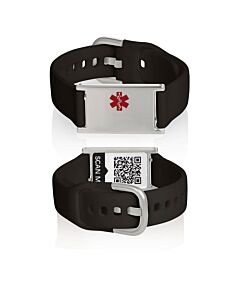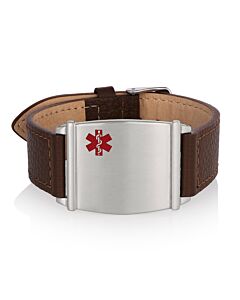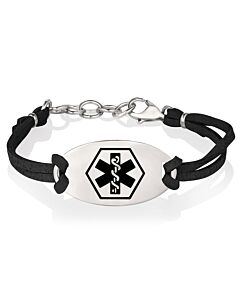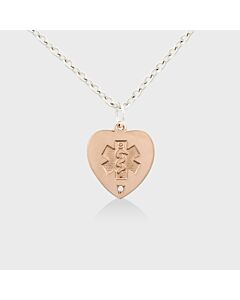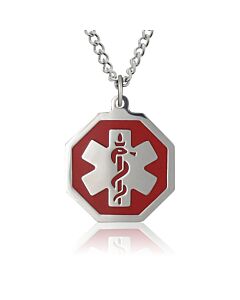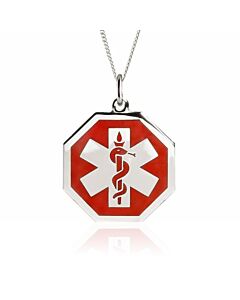

Medical IDs for Aneurysms
A medical ID is recommended to all types of aneurysms. An aneurysm is a disorder of the blood vessels and refers to a weakening of a person's artery wall that can cause a widening, bulge, distention, or ballooning of the aorta. If an aneurysm gets too large, it can rupture and lead to fatal complications.
According to the Society of NeuroInterventional Surgery (SNIS), aneurysms affect approximately six percent of the population. An aneurysm is an invisible disease and is also referred to as the silent killer, which is why it is recommended to wear a brain aneurysm medical alert bracelet or necklace.
Most patients don't know they have an aneurysm until they are found by accident. In an emergency, signs of an aneurysm are not readily visible to responders unless a patient wears an aneurysm medical alert bracelet or necklace to alert others of the presence of or the risk of aneurysms.
Every year, approximately 30,000 aneurysm ruptures occur.
Types of Aortic Aneurysm
The type of an aneurysm is mostly defined by its location. The most common aneurysm of the aorta is an Abdominal Aortic Aneurysm (AAA).
- Thoracic Aortic Aneurysms – an aneurysm that occurs in the chest, also called Thoracic Aneurysm and Aortic Dissection (TAAD).
- Abdominal Aortic Aneurysms – an aneurysm that occurs in the abdomen.
- Cerebral aneurysms – an aneurysm that occurs in the brain.
A medical ID is recommended to all types of aneurysm. Consider wearing a medical ID if you have any or are at risk of these forms of aneurysm.
Who are at Risk of Aortic Aneurysm?
According to the CDC, diseases that damage the heart and blood vessels may increase the risk for aortic aneurysm. These medical conditions include
- High blood pressure
- High cholesterol
- Atherosclerosis
- Marfan Syndrome
- Ehlers-Danlos syndrome
The most significant risk factors are cigarette smoking and family history of aneurysms. Aneurysms are more common in females than in males, and 20 percent of patients will have more than one or multiple aneurysms. The average age of individuals affected by aneurysms is 40-60 years old.
Knowing that you are at risk for aortic dissection puts you at an advantage in the event that you experience unexplained chest, back, or abdominal pain... Medical alert bracelets are helpful, especially if you are unable to provide your medical history. The bracelet can relate a few key words or phrases that may be helpful to emergency department personnel. For example, people with Marfan syndrome might want to include on their bracelet: Marfan syndrome, aortic aneurysm, risk for aortic dissection, heart valve, Coumadin. Talk to your doctor about what is most appropriate for you to put on your bracelet. – Thoracic Aortic Disease Coalition
Medical IDs and Aneurysm in Emergencies
An aneurysm is an invisible medical condition, often without visible symptoms making it difficult for responders to recognize in an emergency. Medical IDs can alert others that aneurysm or the risk of an aneurysm is present.
The greatest asset these patients can be offered by EMS providers is early recognition, followed by appropriate transport to the correct destination. – Journal of Emergency Medical Services
Once there is a rupture, rapid emergency medical treatment is essential, but the Brain Aneurysm Foundation estimates that up to 25 percent of patients encounter a delay or are initially misdiagnosed, potentially costing lives.
What to put on an Aneurysm Medical ID
The most important role of an emergency medical ID is to quickly alert responders of an aneurysm or the risk thereof, to expedite transport to a correct medical facility. Accuracy of medical information presented lies on a medical alert ID’s engraving. A custom-engraved bracelet or necklace is recommended to reflect a patient’s most updated and precise medical information.


Here are some of the most important items to put on an aneurysm medical ID:
- Name
- Aneurysm – you can include the type of aneurysm that you have and other medical conditions such as Marfan Syndrome, Ehlers-Danlos Syndrome, high blood pressure, or diabetes.
- Additional medical information – include information if you have implants like aneurysm clips, pacemaker, etc. and if they are suitable for exams such as an MRI.
- Emergency Contact
- See wallet card – include this on your medical ID tag if you have an emergency wallet card on your person. A wallet card can contain more information about your medical history, including an accurate list of your current medications.
Common Abbreviations Related to Aneurysms
|
AAA – abdominal aortic aneurysm AAD – acute aortic dissection AAO – acute aortic occlusion CAAA – complex abdominal aortic aneurysm repair IAA – Iliac artery aneurysm IAAA – inflammatory abdominal aortic aneurysm
|
MFS – Marfan syndrome RAA – renal artery aneurysm TAA – thoracic aortic aneurysmTAAA – thoracoabdominal aortic aneurysm TEVAR – thoracic endovascular aortic repair vEDS – vascular Ehlers–Danlos syndrome |
Source: Society for Vascular Surgery
A medical professional is the best source of advice on what to engrave on your aneurysm medical ID. Consult your doctor before using any abbreviations to ensure that they are easily recognized and understood by emergency responders.
For tips on engraving and more, please read our guide to choosing a medical ID.
Brain Aneurysm Medical Alert Bracelet & Wristband Options for Adults
If you are shopping for a medical ID bracelet/wristband for you or a loved one, you’ll have many factors to consider. First, start with deciding on the metal type, as we offer medical ID bracelets in stainless steel, sterling silver, titanium, and gold. Then, choose the style that matches you perfectly since you’ll be wearing this medical ID every day.
Our Brain Aneurysm Necklace Options
If a necklace is more suited to your style, we also have many different style metal types and styles available, from durable dog tags to refined gold medallions.
Best-Selling Brain Aneurysm Jewelry
Shop this collection of our best sellers.
Why a Brain Aneurysm Alert Card isn’t Enough
An alert card is a physical card filled out with medical information that wearer’s keep in their wallet or purse. While it is a great idea to complement your medical ID bracelet or necklace with an expandable wallet card, simply having a wallet card without your medical ID is not enough in an emergency situation. Paramedics and emergency personnel will not be aware of your medical ID card in your wallet if you do not present that information first on a bracelet or necklace (where they are trained to first look).
Frequently Asked Questions
Should I wear a medical alert bracelet for aneurysms?
Yes, it is recommended to wear a medical alert bracelet for aneurysms. In a medical emergency, it is important to communicate any conditions, medications, allergies, etc. to medical professionals so they can provide proper medical treatment.
What is the medical brain aneurysm symbol?
There is no icon or symbol for aneurysm. There are some engraving examples of abbreviations in the above section titled “Common Abbreviations Related to Aneurysms” that cover common types of aneurysms and their recognized abbreviations.
Should I still carry an aneurysm alert card if I wear an aneurysm bracelet?
We recommend carrying an expandable wallet card even when wearing a medical ID bracelet or necklace because it provides space for additional helpful information, such as less pertinent conditions, medications, allergies, and emergency contacts. Remember to engrave your critical life saving information on your medical alert jewelry, then include the additional information on your expandable wallet card.



 - US
- US  - Canada
- Canada  - Australia
- Australia 
